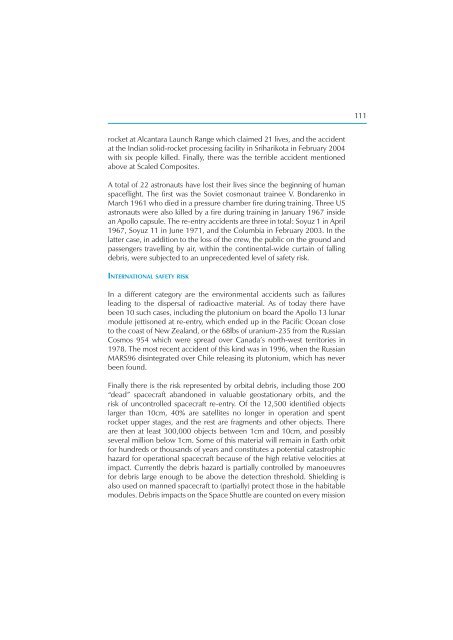Security in Space The Next Generation - UNIDIR
Security in Space The Next Generation - UNIDIR
Security in Space The Next Generation - UNIDIR
You also want an ePaper? Increase the reach of your titles
YUMPU automatically turns print PDFs into web optimized ePapers that Google loves.
ocket at Alcantara Launch Range which claimed 21 lives, and the accident<br />
at the Indian solid-rocket process<strong>in</strong>g facility <strong>in</strong> Sriharikota <strong>in</strong> February 2004<br />
with six people killed. F<strong>in</strong>ally, there was the terrible accident mentioned<br />
above at Scaled Composites.<br />
A total of 22 astronauts have lost their lives s<strong>in</strong>ce the beg<strong>in</strong>n<strong>in</strong>g of human<br />
spacefl ight. <strong>The</strong> fi rst was the Soviet cosmonaut tra<strong>in</strong>ee V. Bondarenko <strong>in</strong><br />
March 1961 who died <strong>in</strong> a pressure chamber fi re dur<strong>in</strong>g tra<strong>in</strong><strong>in</strong>g. Three US<br />
astronauts were also killed by a fi re dur<strong>in</strong>g tra<strong>in</strong><strong>in</strong>g <strong>in</strong> January 1967 <strong>in</strong>side<br />
an Apollo capsule. <strong>The</strong> re-entry accidents are three <strong>in</strong> total: Soyuz 1 <strong>in</strong> April<br />
1967, Soyuz 11 <strong>in</strong> June 1971, and the Columbia <strong>in</strong> February 2003. In the<br />
latter case, <strong>in</strong> addition to the loss of the crew, the public on the ground and<br />
passengers travell<strong>in</strong>g by air, with<strong>in</strong> the cont<strong>in</strong>ental-wide curta<strong>in</strong> of fall<strong>in</strong>g<br />
debris, were subjected to an unprecedented level of safety risk.<br />
INTERNATIONAL SAFETY RISK<br />
In a different category are the environmental accidents such as failures<br />
lead<strong>in</strong>g to the dispersal of radioactive material. As of today there have<br />
been 10 such cases, <strong>in</strong>clud<strong>in</strong>g the plutonium on board the Apollo 13 lunar<br />
module jettisoned at re-entry, which ended up <strong>in</strong> the Pacifi c Ocean close<br />
to the coast of New Zealand, or the 68lbs of uranium-235 from the Russian<br />
Cosmos 954 which were spread over Canada’s north-west territories <strong>in</strong><br />
1978. <strong>The</strong> most recent accident of this k<strong>in</strong>d was <strong>in</strong> 1996, when the Russian<br />
MARS96 dis<strong>in</strong>tegrated over Chile releas<strong>in</strong>g its plutonium, which has never<br />
been found.<br />
F<strong>in</strong>ally there is the risk represented by orbital debris, <strong>in</strong>clud<strong>in</strong>g those 200<br />
“dead” spacecraft abandoned <strong>in</strong> valuable geostationary orbits, and the<br />
risk of uncontrolled spacecraft re-entry. Of the 12,500 identifi ed objects<br />
larger than 10cm, 40% are satellites no longer <strong>in</strong> operation and spent<br />
rocket upper stages, and the rest are fragments and other objects. <strong>The</strong>re<br />
are then at least 300,000 objects between 1cm and 10cm, and possibly<br />
several million below 1cm. Some of this material will rema<strong>in</strong> <strong>in</strong> Earth orbit<br />
for hundreds or thousands of years and constitutes a potential catastrophic<br />
hazard for operational spacecraft because of the high relative velocities at<br />
impact. Currently the debris hazard is partially controlled by manoeuvres<br />
for debris large enough to be above the detection threshold. Shield<strong>in</strong>g is<br />
also used on manned spacecraft to (partially) protect those <strong>in</strong> the habitable<br />
modules. Debris impacts on the <strong>Space</strong> Shuttle are counted on every mission<br />
111








